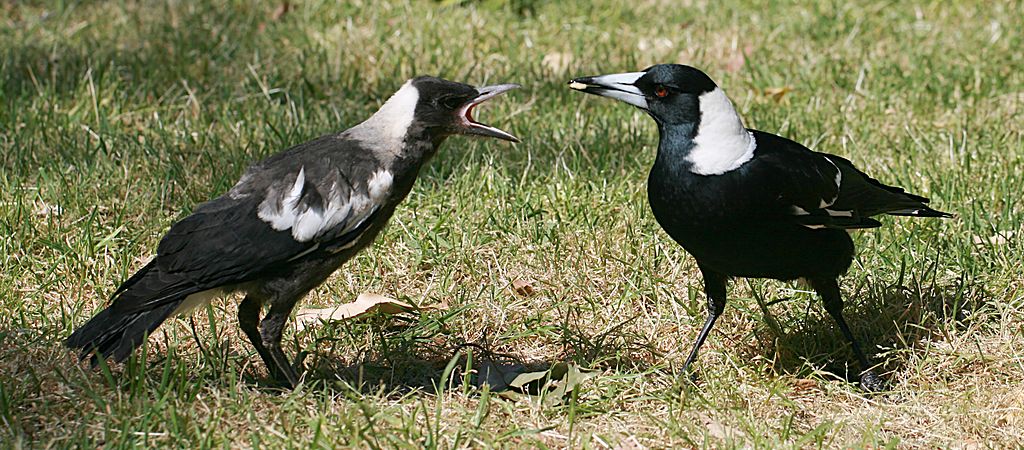
(Full article from RATS Tales July 2020)
Something ominous appears to be happening to the Australian magpie, one of the island continent’s most widespread birds. On Australia’s east coast, the region that includes Sydney and Brisbane, their numbers declined by almost a third between 1998 and 2013. The South East Mainland Region, covering Canberra, Melbourne, and Adelaide, saw a 20 percent drop over the same period. It’s unlikely that the missing magpies are being overlooked. This bird is no furtive cryptic little brown job. Australian magpies are large songbirds with striking black-and-white plumage, loud voices, and brash personalities. Crow-sized and superficially similar to northern magpies, they’re actually corvoids, not corvids—members of a group that includes birds of paradise as well as crows and jays.
They’re best known for their aggressive behavior during the nesting season, when they swoop at bikers and pedestrians, cats and dogs, sheep, model aircraft, and, in recent years, drones. Found throughout Australia except for the deserts, they’ve been introduced to New Zealand (where, in the words of field guide authors Paul Scofield and Brent Stephenson, they’re “loved by many and despised by most”) and Fiji.
Like corvids, Australian magpies aren’t picky about their food, which may include lizards, small mammals, and carrion. That suggests rodenticides may have played a role in their apparent decline, and stories in the Australian news media have suggested as much. Frustratingly, though, hard evidence is lacking. “We think that secondary poisoning is among one of the possible causes of the observed magpie decline,” says Sean Dooley, BirdLife Australia’s National Public Affairs Manager. But he’s not aware of second-generation anticoagulant rodenticides (SGARs) or other rodenticides having been detected in magpies. (There’s stronger evidence for New Zealand, where Australian magpies in the introduced population have died after eating rats poisoned by SGARs in rodent eradication campaigns.) More Australian data is needed, but his organization has no funding for the research that would be required. “We are ramping up a campaign urging our supporters to take the opportunity to make submissions to the Australian regulatory authorities looking at the use of these chemicals,” Dooley adds.
The Australian birds for which secondary SGAR poisoning has been documented are what have been called “traditional raptors”, like boobook owls (Michael Lohr’s research subject) and little eagles. That’s not just an Australian phenomenon: studies in North America, Europe, and Asia have focused on hawks, eagles, kites, owls, and falcons, many of which prey on rats, mice, and other terrestrial vertebrates. However, diet is not a clear-cut distinction between raptors and non-raptors. Some “traditional raptors” specialize in carrion, bones, fish, crabs, flying insects, bee grubs, snails, even fruit (in the case of the palm vulture and some of the caracaras). And many birds outside that taxonomic pigeonhole, including some songbirds and waterbirds, are at least occasional rodent-eaters. Personal observations have included a great blue heron struggling to swallow a sizable rat, common ravens scarfing voles, and a domestic hen in the act of eating a house mouse.
The shrike family is the best-known example of a songbird lineage that has evolved raptor-like beaks and a taste for rodents and other small vertebrates. Most of the world’s 33 shrike species have stable populations, but North America’s loggerhead shrike has disappeared from much of its former range, and the Iberian gray shrike of southwestern Europe is also in trouble. While pesticides are implicated as one of several causal factors, research has been sparse and there’s no conclusive data.
Even for the non-specialists, opportunistic foraging behavior can create exposure to secondary rodenticide poisoning. During the coronavirus pandemic, birds that normally feed on anthropogenic garbage have exploited other food sources. Yellow-legged gulls, close relatives of the North American herring gull, have been photographed eating rats in Rome, and this is probably not a unique case.
Without wading into the still-unresolved argument over which birds are “true” raptors and which aren’t, the possible impact of rodenticides on the Australian magpie supports the case for broadening the scope of research to include other species that play a raptor-like ecological role. Any bird that even occasionally feeds on rodents, living or dead—the magpies, the gulls of Rome, the shrikes and corvids—is potentially at hazard of secondary poisoning, and that risk can only be documented by researchers who think outside taxonomic boxes.
